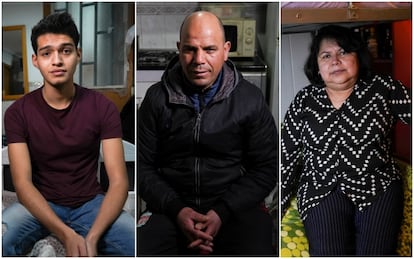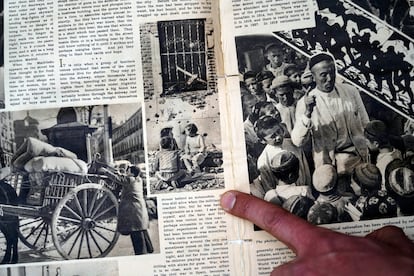Robert Capa photo of shell-damaged houses helps tenants start new life
A picture of the aftermath of Spanish Civil War bombings published in 1937 triggered a successful movement to save a crumbling property from demolition and find decent housing for its struggling residents
The sound of the landmine that killed Robert Capa in Vietnam on May 25, 1954 still reverberates in the Madrid neighborhood of Entrevías, in the southeastern district of Puente de Vallecas. Although many decades have elapsed since then, the residents of a crumbling building located there are familiar with the biography of the 20th-century Hungarian-American photojournalist who became famous for his coverage of wars, including the Spanish Civil War of 1936-39.
The 14 families who live at number 10 on Peironcely street are about to move out after years of putting up with substandard living conditions. Theirs is the shell-damaged building that Capa photographed in November 1936 at the beginning of the Spanish Civil War, when Vallecas was bombed in air raids against the city of Madrid, still held by the republican government. The effects of the attack on the Spanish capital, where civilians were targeted, were also captured by the Sevillian journalist Manuel Chaves Nogales in his book Heroes and Beasts of Spain, first published in English in 1937: “In the heart of the city, the airplanes’ bombs always find flesh.”

Long after the carnage of civilians ended, the brick walls of the house on Peironcely street continued to exhibit the wounds of war. And they still do today, despite a recent attempt to cover up the damage with plaster: the building owner was trying to prevent history from derailing his own plans to tear down the 1927 structure and build new housing at the site. “We told him that he could not cover this up, because this façade is historic,” explains Jesús Rico, 49, who has lived there for a decade with his wife, two daughters, one son and three grandchildren. There, still in plain view, are the white gobs of plaster covering the dents made by the shellfire.
In 1998, a photographer named José Latova identified the spot where Robert Capa had taken a picture that was later published in international news outlets such as The New York Times [see bottom box]. It was a one-story building located in the Puente de Vallecas district of Madrid. But this information was not made public until 2010. When it was, the building stopped being an old house like any other, and a movement sprung up to preserve it. In 2017 it was included on a list of protected city landmarks, in a move that thwarted the owner’s redevelopment plans. Earlier this month the city of Madrid expropriated the building and it will soon relocate its tenants to subsidized housing in the same district.
A lot of the credit for saving the historic building goes to a citizen movement named #SalvaPeironcely10, which in 2018 received recognition from the European Commission for its work to preserve part of the continent’s cultural heritage. “Historic and societal elements come together here to create value,” says José María Uría of the Anastasio de Gracia Foundation, one of the institutions that joined the movement.
Mustafá Labasse, a Moroccan national who moved to the Entrevías neighborhood of Madrid in 1999, is the most veteran resident of the building. He has been there for the last 13 years after taking over the lease from a fellow Moroccan. At first he was paying €510 a month, but the owner has since reduced the rent to €300. Labasse says he has seen dozens of families come and go during this time. People don’t last long because the building is not in good condition, he says. “But since I was living by myself, I didn’t mind being here,” says Labasse, whose wife and daughters are back in Morocco.

“When we first arrived here, it was a little bit complicated, frankly,” confirms Andrés Torres, 17, as he has breakfast in his living room, which is also the kitchen and the bedroom for his mother Cristina. His mother sleeps on a sofa bed wedged between the TV set and the wall and gets up at 4.30am every day to go work in Mercamadrid, the capital’s wholesale market.
“We were living in a bigger house near this one. When we got here, it was in really bad shape,” says her son, who has very vivid memories of a cockroach infestation. “But my mother has made a home out of this.”
Andrés, Mustafá and the rest of the tenants are very grateful to José María Uría for his dedication to their cause. “He is our guardian angel,” says Jesús Rico. Uría not only told them about Capa and the history of their building, but he also led the long process to get these families a new place to live. Although he shies away from the spotlight, Uría has expressed satisfaction at the positive outcome for families who were in a vulnerable situation and on the verge of being evicted from their homes.
“That photograph gave us hope,” says Rico. He and the others will be relocated in subsidized housing later this year after the city expropriated the building earlier this month with a view to giving it a cultural purpose. The tenants are also grateful to Socialist Party (PSOE) councilor Mar Espinar, who supported their cause. “She’s the only fighter we have seen around here,” says Rico.
Neira Adelina, 60, a nursing home assistant who suffers from lupus and spends most of her time between her home and the hospital, says that the old Capa photograph “awoke as though it had been sleeping.” Sitting on the bottom bunk of her bed, she talks warmly about her “little house” despite “the cold, the heat, the damp, the insects, the rats....”
“Who would have thought that we were living in a house that is part of history,” she wonders. “It would’ve been a shame if they’d torn it down.” Her husband Mario, a cook who is out of work because of the coronavirus pandemic, is filling out the paperwork for their relocation.
The property at 10, Peironcely street has taken on historical value through Capa’s photograph, but what it really contains within its walls is 14 substandard homes distributed around two narrow courtyards. Some of the units are not quite 30 square meters in total. The tenants are piled inside what Neira Adelina describes as “homes for dwarves.”
“We don’t know the meaning of privacy around here,” notes Jesús Rico, who started out paying €450 a month rent but is now down to €350, with the occasional default forgiven by the owner. He looks back and remembers the days when he would earn “a good salary” from construction work. Those were the days when he had “a nice apartment with a parking spot.” Later he worked for seven years at the department store El Corte Inglés, and he believed that he would remain with this company until his retirement. But the economic crisis hit, he has been out of work for four years, and the only family income is a monthly check of €430 in state aid and an additional €300 that his wife makes taking care of an elderly man. But Jesús’ problems seem less important to him when he is playing with his grandson Saúl by the old dry well in one of the courtyards.
Earlier this month, the city of Madrid paid the owner €870,000 for the building. The tenants are now being called in to sign the leases on the new subsidized apartments they will be sent to. City officials have not yet said what their plans are for the old property, but they confirmed that it will be used for cultural purposes. The movement #SalvaPeironcely10 has partly developed a project called Robert Capa Center to provide information about the air raids on the capital during the Civil War.
“Who could have guessed that after 80 years, Robert Capa was going to help us in such a big way,” says Neyra. “I wish he could have known about this.”

The bombing of Entrevías, in 'The New York Times Magazine'
Juan Carlos Almazán’s passion for collecting photographs of the Spanish Civil War has made him search through online markets selling old newspapers and magazines. Thanks to this resident of Villarreal (Castellón), the movement #SalvaPeironcely10 found out that the photograph taken by Robert Capa in late 1936 in Entrevías was published in 'The New York Times Magazine' on January 24, 1937. The supplement ran a full feature by William P. Carney on the air raids on the Spanish capital, under the headline 'Life in Madrid: A City of Stalking Death.' The story carried several pictures, including the one of the children on Peironcely street. Almazán recently located a copy of the magazine and bought it for €50 from a US citizen. In the Spanish market, he says in a telephone conversation, it would have cost a lot more. 'The New York Times' (where subscribers can access the story through its digital archive TimesMachine) was not the first international publication to run the picture, however. It had already appeared in the French magazine 'Regards' and in the Swiss 'Zürcher Illustrierte.'
English version by Susana Urra.

